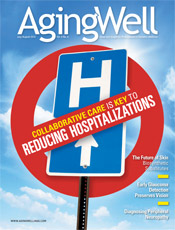
July/August 2012
The High Value of Vitamin DBy Maura Keller Much has been published about vitamin D in the last few years, with epidemiologic studies suggesting a beneficial effect on hypertension, cardiovascular disease, some cancers, and even mortality among older adults. A recent study published in the Journal of the American Geriatrics Society examined the effects of vitamin D on muscle strength, gait, and balance in older adults. The study showed that older adults taking at least 800 to 1,000 IU of vitamin D daily experienced improvement in both their muscle strength and balance. “While these effects remain to be confirmed, the evidence is quite consistent and strong that vitamin D improves fracture rates in older adults and reduces fall rates among those who have low levels,” says Cathleen Colon-Emeric, MD, MHSc, an associate professor of medicine at Duke University Medical Center and associate director of the Geriatric Research Education and Clinical Center at the VA Medical Center in Durham, North Carolina. “The Institute of Medicine recently updated the Recommended Daily Allowance [RDA] of calcium and vitamin D in recognition of this important benefit.” Controversial Topic Marc Leavey, MD, an internist at Mercy Medical Center in Baltimore, says that until a few years ago, physicians couldn’t test for vitamin D levels clinically. Now that such testing is available, physicians are discovering a surprising number of patients who are vitamin D deficient—well over 50% in some series. “Given the known pathologies associated with vitamin D deficiency, screening all adults, not just older or at-risk individuals, would appear to be a good practice. The test is easy and available; the treatment is simple and affordable; and the gains are substantial in preventing morbidity and mortality,” Leavey says. For older adults, vitamin D deficiency can be problematic. “If there is a deficiency, the processes involving calcium metabolism will not function properly, and osteopenia or osteoporosis may result,” Leavey says. “Such bones can fracture without overt injury, leading to significant morbidity. Of five older women who break a hip, two will die, two will end up in an extended care situation, and one will recover. We need to prevent [vitamin D deficiency] whenever we can.” Recommending Supplements Unfortunately, most older adults do not get the necessary vitamin D from their diets. “Very few foods contain appreciable amounts of vitamin D. Humans were never designed to eat vitamin D; we were designed to make it by living outdoors,” Binkley says. Vitamin D is primarily made by the skin in response to sunlight exposure and is found naturally in only a few foods, such as fatty fish, eggs, and liver. Although more foods are being fortified with vitamin D, including milk, margarine, and orange juice, these tend to have about 100 IUs per serving, and adults over the age of 70 would therefore require eight or more servings per day to meet the current RDA. That’s where supplements come in. “Supplements come as vitamin D2 [ergocalciferol] or D3 [cholecalciferol] and although they have a slightly different biologic potency, both seem to raise 25(OH) vitamin D levels to a similar extent and are acceptable as supplements,” Colon-Emeric says. Physicians often prescribe high supplement doses for severe vitamin D deficiencies. But experts agree this practice is controversial and requires more research. “Several recent studies showed that infrequent, ultra–high-dose vitamin D—300,000 to 500,000 IU yearly—does not reduce, and may paradoxically increase, fall and fracture rates,” Colon-Emeric says. “This may be due to a rapid elevation in 1,25(OH) D2 levels, which can impair bone formation and increase skeletal resorption. In contrast, doses up to 100,000 IU quarterly appear to be effective in reducing fractures. Until we better understand the impact of very high intermittent vitamin D, sticking to moderate doses daily, weekly, or monthly seems prudent.” Key Calculations While there are no strong data to suggest that supplements are better or worse than sunlight exposure, since such exposure can cause skin damage, many Americans limit their sun exposure and wear sunscreen, making supplements more necessary. It also appears that, based on an individual’s age, the skin’s ability to make vitamin D in response to sunlight decreases. “Moreover, fall and fracture risk continues to increase with age, so older adults actually need supplements more than younger adults do,” Colon-Emeric says. “My practice is to continue supplements for patients who are ambulatory or at high risk for fractures as long as it is consistent with their goals of care.” It’s also important to keep in mind that vitamin D can affect neuromuscular function. As Leavey explains, vitamin D is intimately connected to calcium metabolism. “In patients with severe vitamin D deficiency, one may develop hypocalcemia, which can lead to bone pain and, if severe, problems with nerve conduction,” Leavey says. “These are serious complications which should be seen and treated promptly.” — Maura Keller is a Minneapolis-based writer and editor. |
![]()
